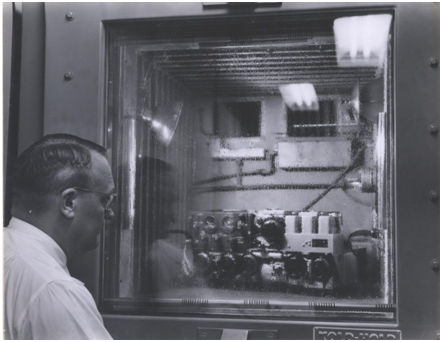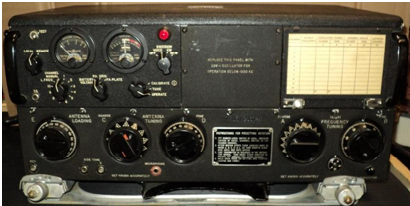ATC & AN/ART-13, JAN T-47/ART-13 TRANSMITTER
Copyright 2013 CCA
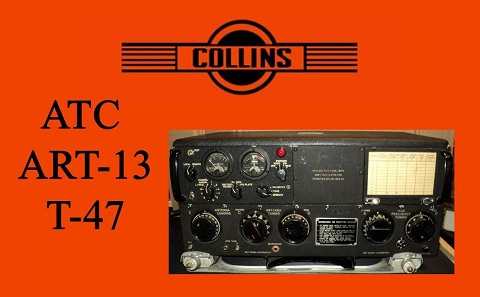
Probably – No, most certainly! – this is the ubiquitous Collins World War II transmitter. When you think of the Collins Radio Company during the WW II period, you naturally think of this family of transmitters – and rightfully so. Derived from the original commercial aircraft line of Collins Autotune transmitters of the 17D prewar family, this ruggedized and beautifully designed 100 watt HF transmitter was, and still is, the pride of Collins Radio. It flew in many aircraft ranging from heavy bombers down to multi seat fighter bombers and eventually into some of the larger single engine/single seat fighters like the P-47 and the P-38 Lightning. It had a reputation for reliability and ease of use that was second to none in its category of radio. This transmitter flew throughout WW II and well beyond the war even out into the late 50s and even 60s and was used by many Air Force, Navy and civilian aircraft. The reliability of these transmitters was no accident. Not only were they the product of the obviously quality oriented design philosophy of the employees indoctrinated by Arthur Collins, but they were thoroughly evaluated and tested for reliability under worst case conditions.
Here below we see Ted Hunter, Chief Engineer in 1942, watching over the humidity chamber testing of an early version of this transmitter. It is interesting to note that Gene Senti, one day to be the Group Head of HF & Amateur Radio Com at Collins Radio, was one of the final test engineers on the ART-13/ATC project early in the war.
Ted Hunter, Chief Engineer & Father of the PTO Oversees Environmental Testing of the early ATC Project Lead engineer Frank Davis and ME Roy Olsen successfully developed the ART-13 in spite of confusing Navy specifications. 90,000 of these transmitters, of basically four different configurations, were manufactured.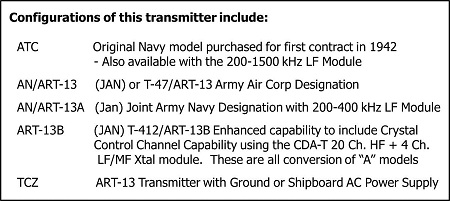 Early LF Modules were 200-1500 kHz whereas later ones were 200-600 kHz.
Early LF Modules were 200-1500 kHz whereas later ones were 200-600 kHz.
 T-47/ART-13 Top View (LF Module Installed)
Photo Compliments: http://www.radioblvd.com/art13.htm
Common Characteristics:
T-47/ART-13 Top View (LF Module Installed)
Photo Compliments: http://www.radioblvd.com/art13.htm
Common Characteristics:
AM/MCW or CW Operation 100 Watt AM Capability 2.0 to 18.1 Mhz Reduced Pout (50%) above 25,000 ft for arc reduction 10 Channel Autotune plus one LF and Manual Channel Typical Input Power (658-896 Watts) Depending on Configuration and Pout Audio Input Required (Dynamic 16 mV or Carbon Mic) Selectable Audio Response: 300 Hz to 4000 Hz +/- 3 db w/ < 15% distortion Tuning Time < 25 Seconds at or above 28 Vdc
For more information on maintaining and using the ART-13 family of transmitters in today’s environment, see the bottom of this page for related links and some great video. Recently the CCA was fortunate to collaborate with the Rockwell Museum as we shot a number of video clips of an ART-13 maintenance expert who learned his trade under the pressure of the Berlin Airlift.
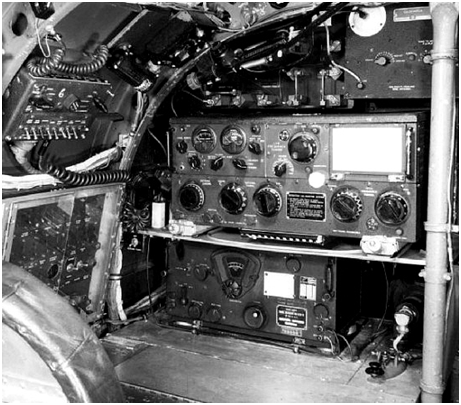 ART-13 and BC-348 Receiver as Installed in a Lancaster Bomber
ART-13 and BC-348 Receiver as Installed in a Lancaster Bomber
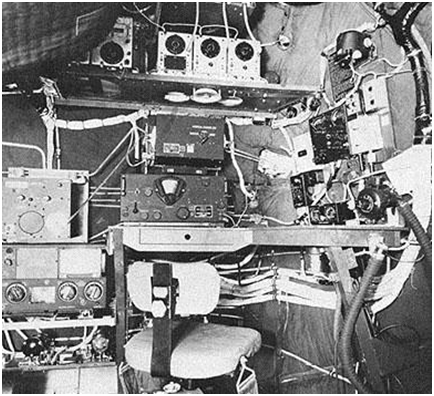 ART-13 and BC-348 Receiver install in B29
Tube Line-up:
ART-13 and BC-348 Receiver install in B29
Tube Line-up:
837 Oscillator (PTO) 1625 (2 ea) Multipliers 813 Power Amplifier 811 P-P Modulators (2 ea) 6V6 (2) & 12SJ7 Audio & Side tone 12SL7 (2) & 12SA7 MCW/200 kHz Freq. Calibration Indicator (Osc) 1625 LFO Oscillator (If installed)
Early ATC without the O-16 LF Module Common Accessories:DY-11 & DY-12 Early Dynamotors DY-17A Later and More Common Dynamotor LF Module 200-600 kHz (O-17) LF Module 200-1500 kHz (O-16) LF/MF/HF Crystal Control Module (Applicable B Model Only) Control Head (C-87, Early or C-740, Zeus Mount) Antenna Couplers (CU-25, CU-26 and CU-32) – See Manual Antenna Shunt Capacitor Assembly (CU-24)
The TCZ is a ground or ship based version of the ATC or ART-13 which is basically a Standard ART-13 mounted on a very robust shore (ship) based 115 Vac Power Supply.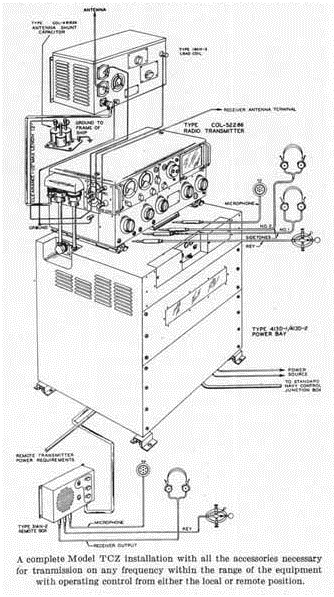 Introduction:
While “Introduced” in 1942, the ART-13 did not enjoy any advertising exposure until many years later. At first considered highly classified, there were no images or paperwork releases until very late in the war. In 1944, seeing the end of the war in sight, Collins released an ad showing the Autotune Module out of the ART-13. By that time, they knew that both the Japanese and the Germans had captured and reverse engineered this module.
Introduction:
While “Introduced” in 1942, the ART-13 did not enjoy any advertising exposure until many years later. At first considered highly classified, there were no images or paperwork releases until very late in the war. In 1944, seeing the end of the war in sight, Collins released an ad showing the Autotune Module out of the ART-13. By that time, they knew that both the Japanese and the Germans had captured and reverse engineered this module.
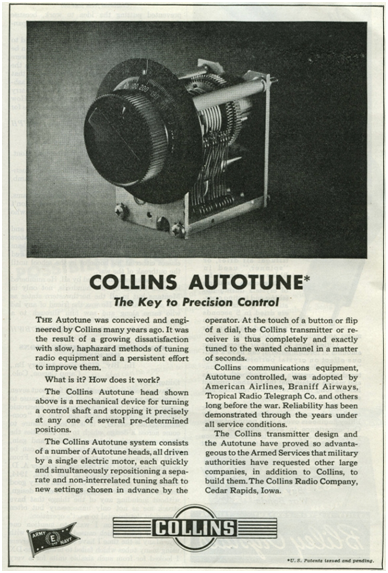 QST, October of 1944
By the following year, the war was nearing the inevitable end, and Collins could now “toot their horn” a little.
QST, October of 1944
By the following year, the war was nearing the inevitable end, and Collins could now “toot their horn” a little.
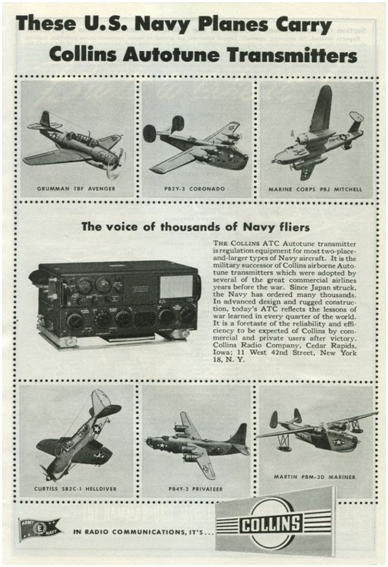 QST, May of 1945
QST, May of 1945
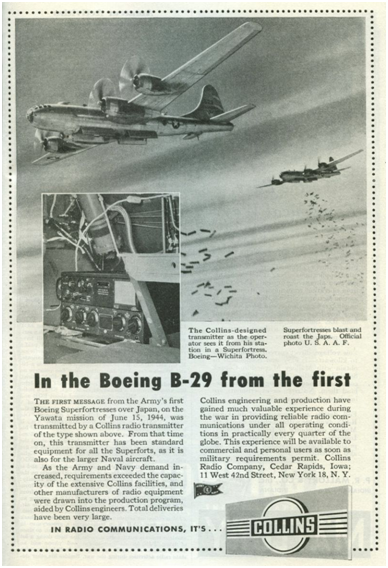 QST, July of 1945
They certainly did not need to advertise that rig. It was already famous in its own right and the ensuing reputation that Collins built during the war would serve the company well for many years to come.
Operating the ART-13 Today:
Following are some great links to help you understand the operation of this transmitter today.
In early 2013, the CCA collaborated with the Rockwell Museum to document the history and skills of a very interesting gentleman. Jules Yoder KW0Y, is a retired Rockwell Collins Engineer who, prior to his career at Rockwell, was an Army Air Corp Tech maintaining ART-13 equipment during the pressures of the non-stop Berlin Airlift.
In the following video clips, Jules shares with us some of that history and his thoughts on maintaining the ART-13 today. Although retired now, Jules is still very active with the Rockwell Collins Museum Club and has recently overhauled three ART-13s that were pressed back into service in the restored radio operating position of the only airworthy and flying B29 in the world – Fifi.
There is more on the Fifi project and the radio room operation on this website. Click here for more on Fifi.
Jules Yoder Videos:
ART 13 – Introduction and History
ART-13 – Description and Disassembly
ART-13 – AutoTune Function
ART-13 – AutoTune Adjustment Part 1
ART-13 – Auto Tune Adjustment Part 2
ART-13 – Service Tips
Additional Links for Information:
http://www.radioblvd.com/art13.htm
http://rockwellcollinsmuseum.org/artifact_collection/
QST, July of 1945
They certainly did not need to advertise that rig. It was already famous in its own right and the ensuing reputation that Collins built during the war would serve the company well for many years to come.
Operating the ART-13 Today:
Following are some great links to help you understand the operation of this transmitter today.
In early 2013, the CCA collaborated with the Rockwell Museum to document the history and skills of a very interesting gentleman. Jules Yoder KW0Y, is a retired Rockwell Collins Engineer who, prior to his career at Rockwell, was an Army Air Corp Tech maintaining ART-13 equipment during the pressures of the non-stop Berlin Airlift.
In the following video clips, Jules shares with us some of that history and his thoughts on maintaining the ART-13 today. Although retired now, Jules is still very active with the Rockwell Collins Museum Club and has recently overhauled three ART-13s that were pressed back into service in the restored radio operating position of the only airworthy and flying B29 in the world – Fifi.
There is more on the Fifi project and the radio room operation on this website. Click here for more on Fifi.
Jules Yoder Videos:
ART 13 – Introduction and History
ART-13 – Description and Disassembly
ART-13 – AutoTune Function
ART-13 – AutoTune Adjustment Part 1
ART-13 – Auto Tune Adjustment Part 2
ART-13 – Service Tips
Additional Links for Information:
http://www.radioblvd.com/art13.htm
http://rockwellcollinsmuseum.org/artifact_collection/
Finally, don’t miss your opportunity to work the real B29 operation position on Fifi. Fifi’s operation centers around her airshow schedule. You can follow this opportunity by watching the Fifi link on our website here and by watching the news headlines. Whenever possible we give advanced warning when Fifi is going to be on the air.
– – – – – – – – CCA – – – – – – – Note: The images and text used in these pages are copyright 2013 © protected, are restored and written by the Collins Collectors Association or its representatives, and may not be used in any other commercial or website applications. They may be downloaded and used privately – not for publication or internet use.
- CCA COLLINS HISTORICAL ARCHIVES
- The Pre War Years
- The War Years
- ART 13 - Description and Disassembly
- ART 13 AutoTune Adjustment Part 1
- ART 13 AutoTune Adjustment Part 2
- ART 13 AutoTune Function
- ART 13 Introduction and History
- ART 13 Service Tips
- ATC & AN/ART-13, JAN T-47/ART-13 TRANSMITTER
- Post War Broadcast / Commercial
- The Black Boxes
- The Grey Boxes
- The “S” Word or Solid State
